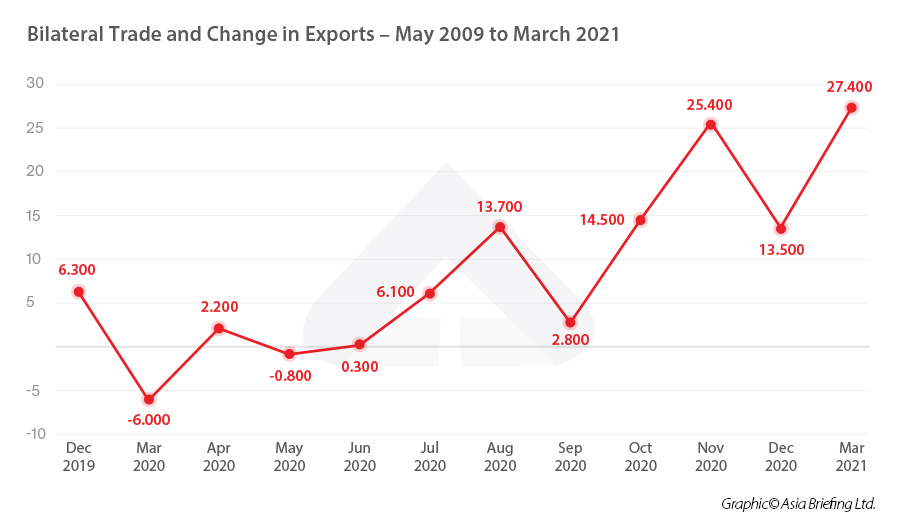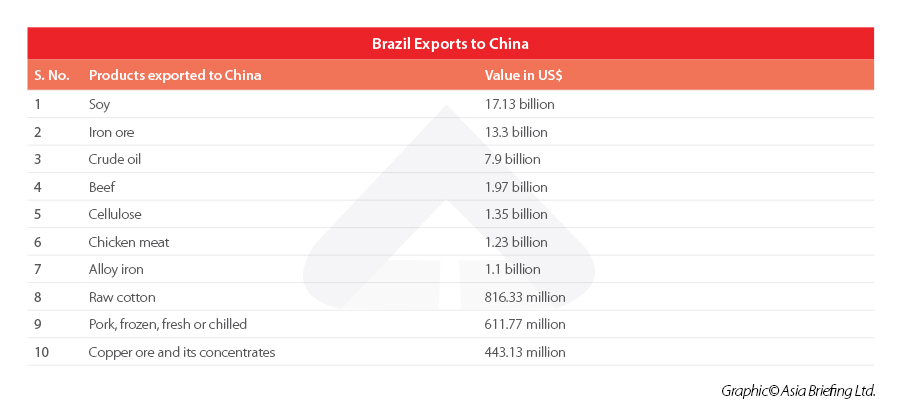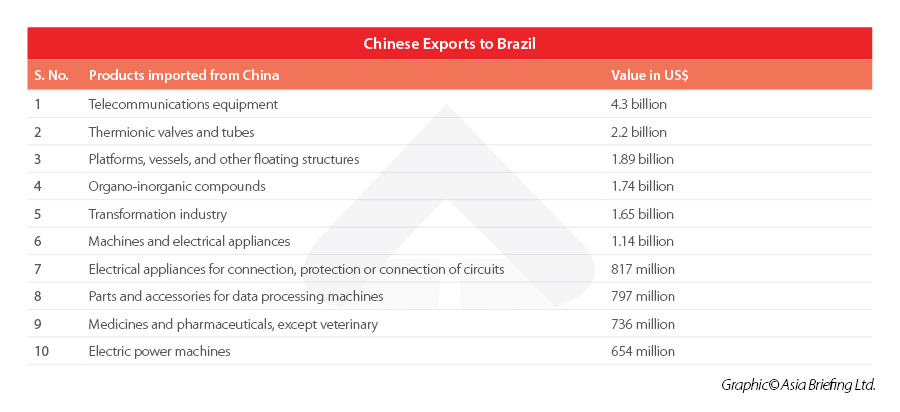Bilateral Trade Between Brazil and China
Op-ed By Patrícia Varejão, Contributor, Dezan Shira & Associates
China has been Brazil’s most important trade partner since 2009. In relation to international trade, it is characterized by being Brazil’s largest buyer and investor. This phenomenon even affects the country’s trade balance. Regarding the BRICS (Brazil, Russia, India, China and South Africa), which is led by China, Brazil is a very important participant in the bloc.
However, since Jair Bolsonaro took over the presidency in 2019, this parameter has ceased to exist because the president and his international governance advisors started to assume pro-US commitments (namely pro-Donald Trump) habitually censoring China.
Current bilateral trade figures
The increase in exports is around 37.7%, while imports increased 25.9% in the first half of 2021. The total trade transacted between Brazil and China in 2021 may be greater than 2020, which was around US$ 102.5 billion.
Exports from Brazil to China were around US$ 46.747 billion in the semi-annual period, while in relation to imports, the Chinese volume was around 21.7%, around US$ 21,507 billion.
The record of imports and exports between Brazil and China has so far yielded a surplus of US$ 25,241 billion, whereas last year it was registered US$ 33,010 billion. This is as per the SECEX (Secretaria de Comércio Exterior / Secretariat of Foreign Trade), a branch of the Ministry of Economy.
Soybeans, which accounted for 37% of exports to China, traded US$ 17.13 billion, in second place we have iron ore with a share of 29% which represents US$ 13.3 billion and lastly crude oil, which represented 17% of total sales, which means US$7.9 billion.
Another highlight is beef exported to the Asian country, representing 4.2% of exports, which means US$ 1.97 billion, and cellulose representing 2.9% of exports, which means US$ 1.35 billion.

Types of products traded with China
The 10 main products exported to China are soy, iron ore, crude oil, beef, cellulose, chicken meat, alloy iron, raw cotton, pork – frozen, fresh, or chilled, and copper ore and its concentrates.
See the table below:

The 10 main products imported from China are: telecommunications equipment, thermionic valves and tubes, platforms, vessels and other floating structures, organo-inorganic compounds, transformation industry, machines and electrical appliances, electrical appliances for connection, protection or connection of circuits, parts and accessories for data processing machines, medicines and pharmaceuticals, except veterinary, electric power machines.

China business trends
With the advent of the coronavirus pandemic, China was one of the few countries that managed to stabilize its economy somewhat in 2020 that shaped the behavior and economic recovery of other countries. In 2021, it appears to have stayed the same.
The Asian giant is moving towards high tech innovation with futuristic applications and more sophisticated models of manufacturing and development.
The economic collapse induced by the pandemic compromised global markets and even impacted developed countries. But the crisis has firmly put in place a digital model of commerce that continues to expand into 2021.
Meanwhile, China continues to be one of the most successful markets and is on board to pioneer new developments in the globalized world, especially with regard to artificial intelligence, sustainable development, and e-commerce.
The five trends for businesses in China are: expanding artificial intelligence (AI), digitizing the value chain, sustainable development, livestreaming, and social commerce.
Expanding artificial intelligence
In recent years, the news in this sector has increased a lot. Research has gained more space and the development of technologies as well as technological evolutions have allowed artificial intelligence to become increasingly accessible. According to Alibaba DAMO Academy, the application of AI in the agribusiness, medicine, and neural engineering sectors are the big news in the market.
The novelty in agribusiness is already being applied with the use of digital methodologies to analyze data and monitor production. New agriculture is increasingly data dependent and less subject to climatic conditions. In China, the Alibaba group used its blockchain technology to monitor the transport and safety of agricultural products and showed how to address the gap between planning, producing, and selling this type of product.
In medicine, AI has been widely used to explain medical images and manage records.
Digitizing the value chain
The onset of the pandemic helped to accelerate the digital economy that is here to stay. In addition, the storage issues and slowdown caused by managing huge amounts of data produced every day encouraged traders to digitize their processes.
The value chain is a method that allows the company to organize all its processes, observing the links and how each one can generate value for the customer. It is characterized by being vast, complex, and having a large volume of information. Due to this, it cannot be managed manually. In this way, AI resources are applied to improve the most varied values involved. Classic examples: native “cloud” chips, platforms, and applications.
Sustainable development
Green development is one of the goals of the globalized world. It is necessary to reflect on the inheritance that future generations will receive. Therefore, several countries are making their way in order to overcome the external costs that have increased since the industrial revolution.
According to Valor Econômico, the second largest economy in the world aims to improve its level of development. As it enters a new level of growth, many regions across China are looking to improve its strengths.
President Xi Jinping has highlighted several key words crucial for development in the coming years: new development paradigm, green transformation, people-centered philosophy and high quality development.
These words are important concepts that were presented in China’s latest development project: the preliminary draft of the 14th Five-Year Plan (FYP) (2021-2025) for Economic and Social Development and Long-Term Goals to 2035, which is under review at the fourth session of the 13th National People’s Congress (NPC), the main legislature of China.
Live streaming
According to Revista Veja, live streaming is the new consumption phenomenon in China. E-commerce has sparked a revolution in traditional retail. Now Chinese sales show can do the same with applications and online stores.
Although digital stores are very present in the daily lives of Chinese people, the physical store was not without its relevance. So when the pandemic hit, profits dropped and, to survive, stores had to focus on online operations. Live streaming is a feature in applications like Taobao, Kuaishou, and iQiyi and were popular apps chosen and saved the lives of many companies during the lockdown period.
Live streaming is no longer an option, but a necessity in retail and with the new features of simultaneous translation and virtual hosting, the perspective is that this market will only grow, and the trend will expand to other countries.
Social commerce
The growing use of mobile devices and social networks is fostering a new type of e-commerce, social commerce. This is a subcategory of digital commerce that takes place on social media platforms and is gaining more adherents every day. It works on an organic and well-structured interaction with the platform itself, together with the growing use of these applications for various purposes and the possibility of leaving your comments about the product and the seller, has made this modality a trend.
In China, the extensive use of these platforms has reshaped the e-commerce landscape, affecting both the way people buy and the way sellers advertise and sell their products. The Asia-Pacific Foundation of Canada says that there are three factors most relevant to the success of the social commerce model in China: a well-developed e-commerce ecosystem, a large number of internet users connecting through mobile devices, and the QR code and mobile payment tools.
Without a doubt, Millenials and Generation Z have been driving the growth of social commerce, and such success has been attracting the attention of Chinese investors. The FBIC Group currently assesses the size of the social commerce market in China at 1,657.8 billion renminbi and estimates a growth of more than 45% by 2022, reaching 2,419.4 billion renminbi.
Number of Brazilian companies that invested in China
I found data only from 2012 that reported that the number of Brazilian companies that invested in China is only 57. Without a doubt, this information is outdated.
On the other side, there are several articles about the number of Chinese companies that invest in Brazil.
Currently, more than 300 Chinese companies invest in Brazil, 25 of which are among the top 500 in the world.
About Us
China Briefing is written and produced by Dezan Shira & Associates. The practice assists foreign investors into China and has done so since 1992 through offices in Beijing, Tianjin, Dalian, Qingdao, Shanghai, Hangzhou, Ningbo, Suzhou, Guangzhou, Dongguan, Zhongshan, Shenzhen, and Hong Kong. Please contact the firm for assistance in China at china@dezshira.com.
Dezan Shira & Associates has offices in Vietnam, Indonesia, Singapore, United States, Germany, Italy, India, and Russia, in addition to our trade research facilities along the Belt & Road Initiative. We also have partner firms assisting foreign investors in The Philippines, Malaysia, Thailand, Bangladesh.
- Previous Article Belt and Road Weekly Investor Intelligence, #45
- Next Article Guangdong-Macao Intensive Cooperation Zone to Enjoy Free Trade Port Treatment









